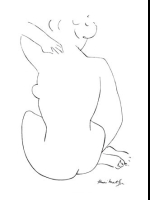Psychophysics of human vision
During my PhD at Scuola Normale Superiore in Pisa (with Concetta Morrone), I used tools from psychophysics, fMRI and computational modeling to investigate how the human brain processes visual information coming to the retina. In particular I focused on the question of how the brain encodes the brightness of visual objects.
The role of luminance edges and lines

 (paintings by Henri Matisse)
(paintings by Henri Matisse)
To some extent, either edges or lines can be used indifferently without affecting the recognizability of the scene.
Parallel processing and integration
Brightness encoding
Both edges and lines are important for the recognition of visual objects, but edges (and only them) play an additional important role in determining the appearance of the surfaces they enclose. This is shown by the existence of visual illusions such as the "Cornsweet Craik O'Brien illusion" represented here. The circle is exactly the same gray level as the rest of the image, but we perceive it as brighter. In some way the brain infers the characteristics of the circle and of the external surface from the high spatial frequency edges.
The different brightness of the circle is not in the image nor on the retina, but it becomes explicit somewhere in the brain. What is the nature of the signals that encodes surface information? Are there neurons in retinotopic visual areas firing in response to the illusory brightness? Or the surface attributes -and the surface itself- is simply ignored by the brain?

Related scientific publications
- Perna et al. "Neuronal mechanisms for illusory brightness perception in humans". Neuron (2005) [Pdf] [Web]
- Perna and Morrone "The lowest spatial frequency channel determines brightness perception". Vision Research (2007) [Pdf] [Web]
- Perna et al. "BOLD response to spatial phase congruency in human brain". Journal of Vision (2008) [Pdf] [Web]